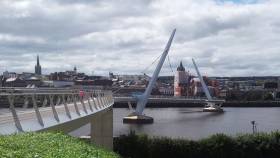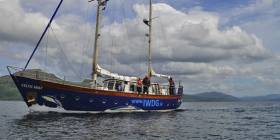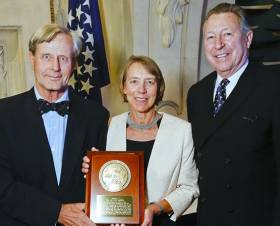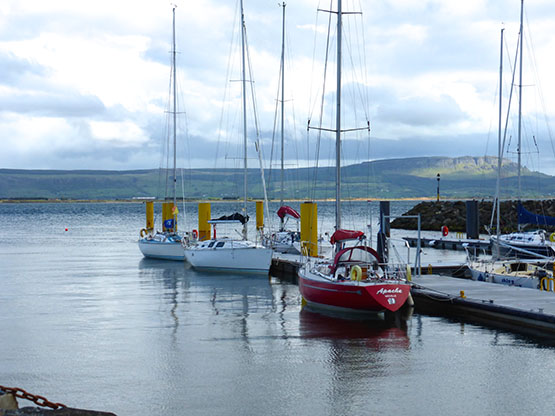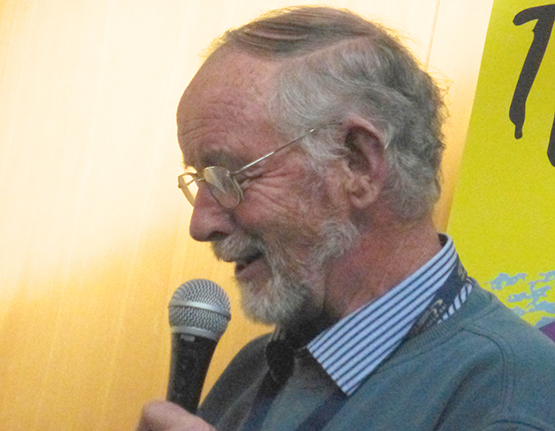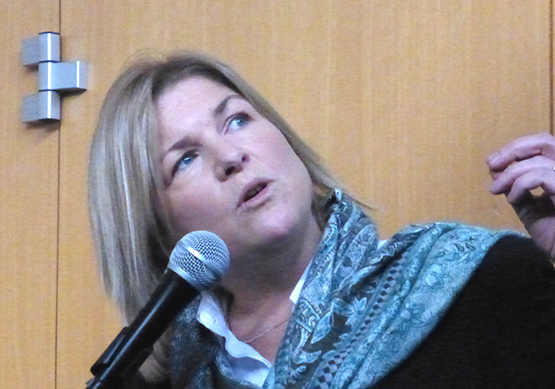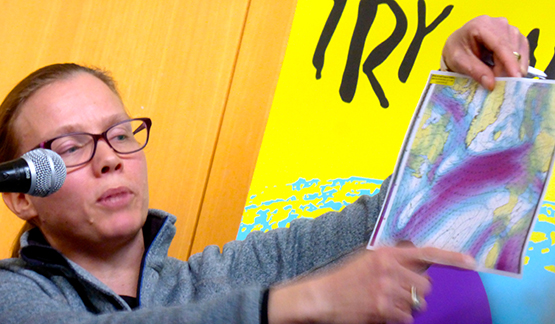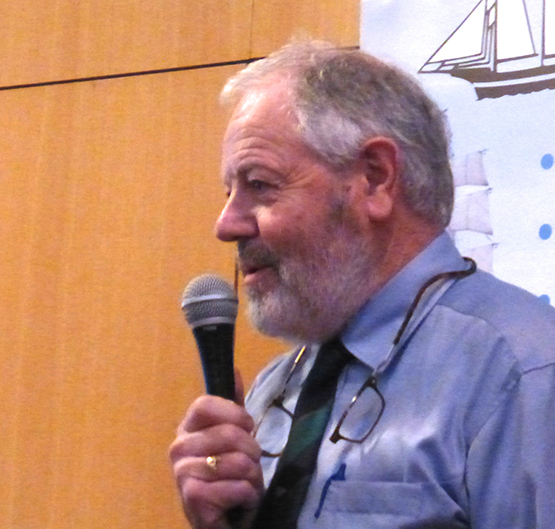Displaying items by tag: Cruising
#CoolRoute - With their city's namesake yacht's performance in the Clipper Race firmly in mind, Derry officials met with fellow Cool Route partners in Glasgow last week ahead of hosting their own project meeting this October.
As Derry Now reports, the recent two-day gathering allowed partners in the Cool Route cruising initiative to discuss various aspects of the project, with Derry leading talks on IT and online booking.
Cool Route partners – which include Cork Institute of Technology and Donegal County Council – also met with marine leisure industry stakeholders to share insights and feedback.
Derry Now has more on the story HERE.
#MarineWildlife - Places are going fast for a special cruise on board the Irish Whale and Dolphin Group's Celtic Mist to celebrate the 25th anniversary of Ireland's whale and dolphin sanctuary.
Celtic Mist will depart Fenit, Co Kerry next Saturday 7 May with a team of IWDG members and marine science experts on an almost three-month circumnavigation of Ireland, first heading north along the Wild Atlantic Way and around to the Irish Sea, calling on Dublin on 7 June to mark the 25th anniversary of the Irish Government's official declaration of this island's waters as a sanctuary for cetaceans.
The declaration came only three months after it was proposed by the then newly formed IWDG, and both have been instrumental in raising awareness of the bounty of marine wildlife in Irish waters.
Though berths on the voyage are filling fast, everyone will have the opportunity to participate by assisting in outreach events along the cruise route, or by tracking its progress online. Details on how to get involved can be found on the IWDG website HERE.
Along the way passengers on Celtic Mist may be treated to some of the incredible wildlife the sanctuary was created to protect, such as humpback whales – a number of which were spotted on an early visit to West Kerry earlier this month, likely attracted by schools of sand eels, as the IWDG reports.
In other marine wildlife news, locals near a beach close to Ballyshannon in Co Donegal have complained after a whale carcass was left rotting on rocks three days after it was reported to authorities.
According to the Irish Mirror, successive high tides had failed to shift the 25ft minke whale, though Donegal County Council says it is arranging for the animal's disposal.
When This Boat Crew Realised What They Were Seeing, It Was Almost Too Late To Escape!
We don't really think about it on a daily basis, but the Earth is still changing all the time. It just happens so slowly that we can't really perceive it. But every now and then, things speed up… a lot. Check out these photos below to see what a cruising yacht in the South Pacific witnessed.

As they got closer, what they had taken to be a sandbar revealed itself to be something else entirely.


A huge amount of pumice stone was floating to the surface of the water. It looked like a beach.

They decided to get a closer look and redirected their yacht towards it.

It looks like a beach in the middle of the ocean!

The crew decided to sail through it, leaving a break in the stone behind them as they went.

They wondered what could have caused this expanse of stone to suddenly appear.

The field of pumice was getting even larger as they passed through it. The crew had an uneasy feeling and upped their speed.

Once they were a safe distance away, they heard a faint rumbling. Looking back they saw water bubbling from the surface.

The source of the pumice stone was an underwater volcano that was actually erupting at the time!

They anchored to watch this tremendous event. Massive plumes of smoke filled the sky.

As the smoke cleared, they noticed something strange just at the water's surface...

It was land!

The stunned crew couldn't believe what they were seeing: It was the actual birth of a new island.

They sailed a little bit closer to see if their eyes were playing tricks on them.

But it was real. The peaks of this new land mass were already taking form.

It was one of the rarest events imaginable!!!

They were able to witness such an impossible sight… and also they apparently very narrowly escaped with their lives!
CIT's Cool Route Project Invites Alumni To Try Sailing
#CoolRoute - Cork Institute of Technology (CIT) is inviting alumni and friends – especially those with no previous experience – to 'Try Sailing' at a yacht club near you.
The drive comes from a partnership between CIT, the Royal Cork Yacht Club and the Irish Sailing Association and falls under the remit of CIT's Cool Route Project, which aims to attract business to peripheral locations by promoting yacht cruising on the scenic coastline of North West Europe.
Capitalising on the current big push to attract young people to sailing and cruising, 'Try Sailing' developed as a result of discussions with with ISA and RCYC via the CIT Cool Route team.
Individuals and groups alike are encouraged to head to Crosshaven – one of many other participating clubs around the coastline – to take out a 1720 class racer with an instructor for three hours, all necessary safety gear provided and no previous experience necessary.
While there is a small fee involved, there are possible group discounts for CIT alumni and friends.
For more details visit the Try Sailing website, follow the hashtag #eucoolroute on social media or visit Facebook.com/eucoolroute
Cruising Club of America Celebrates 2015 Award Winners
From across the globe, members of the Cruising Club of America (CCA) assembled at the New York Yacht Club in Manhattan to recognise their outstanding sailors of 2015 during the international organisation’s Annual Awards Dinner earlier this month.
Representing a broad array of sailing achievements, the recipients of the 2015 Blue Water Medal and the Blue Water Medal “Without Date,” Far Horizons Award, Rod Stephens Trophy for Outstanding Seamanship and the Richard S. Nye Trophy were celebrated for their accomplishments.
2015 Blue Water Medal and Blue Water Medal “Without Date”
The Cruising Club of America presented British sailors Tom and Vicky Jackson its 2015 Blue Water Medal, established in 1923 to recognise examples of meritorious seamanship and adventure upon the seas. The Jacksons were rewarded for their extensive racing and cruising, over more than 34 years aboard their 40’ Sparkman & Stephens-designed Sunstone.
The Cruising Club of America presented Jon Sanders of Perth, Australia, its Blue Water Medal “Without Date.” The medal recognises examples of meritorious seamanship and adventure upon the seas and has only been awarded seven times to recognize a variety of achievements. Sanders has made nine circumnavigations – eight of them solo, including a single “three times around” voyage, and one crewed – and has made a lifetime of significant contributions to sailing.
Far Horizons Award
The 2015 Far Horizons Award was presented to Kaspar and Trisha Schibli, of Victoria, British Columbia, in recognition of their extensive offshore cruising, especially their current multi-ocean cruise.
Richard S. Nye Trophy
The 2015 Richard S. Nye Trophy was presented to John E. Sanford of Tiburon, Calif., for meritorious service to the CCA and the San Francisco Station over a period of 34 years.
Rod Stephens Trophy for Outstanding Seamanship
The 2015 Rod Stephens Trophy for Outstanding Seamanship was presented to Canadian cruisers George Juri and Grit Chiu for their lifesaving rescue in critical conditions of a man found floating offshore who had been in the water for four days following the sinking of a work barge off Phuket.
The ultimate dreamworks for those who cruise the Irish coast, or indeed those who just hope to do so one day, has been reaching distributors and subscribers this week with the 14th Edition of the Irish Cruising Club’s Sailing Directions for the South & West Coasts of Ireland coming hot off the press writes W M Nixon.
It’s only three years since the 13th Edition was published, but as Ireland emerges from recession, new harbour developments are taking place. And as well, Honorary Editor Norman Kean, ably assisted by his wife Geraldine Hennigan, is constantly up-dating information, and receiving input from ICC members and other interested folk in all sorts of out of the way places, adding to the already enormous shared stock of top class local knowledge about harbours and anchorages large and small.
The book is available to purchase directly from distributors Todd Navigation via the Afloat marketplace here.
In this age of electronic navigation, it may surprise some that there is a continuing demand for new editions of a book which was first compiled by the great Harry Donegan of Cork in 1930, and he in turn had been collating information, and making harbour charts aimed at the needs of cruising enthusiasts, since 1912.

With clear chartlets like this, the ICC makes secret anchorages such as Golam Harbour on the south coast of Connemara accessible to cruising folk from other areas. Courtesy ICC
But in fact this history going back more than a hundred years is part of the book’s attraction. And despite today’s gadgetry, no serious cruising person would contemplate heading off for a detailed venture along the Irish coast without a copy of it on board.
The mixture of technical information well leavened with clear charts and evocative photographs has improved steadily over the years, and the Foreword from Roger Millard, the recently-retired Regional Geographic Manager at the Admiralty Hydrographic Office, neatly encapsulates the high regard in which the ICC Directions are held, as he comments: “Although aimed at small-craft users, it has many admirers from major maritime institutions”.
His Foreword’s conclusion provides a warmth of support beyond professional admiration. Having listed the Directions’ special features of invaluable assistance to small craft users, he concludes: “On top of these advantages, I find it a fascinating read, and I am sure you will enjoy it”.

Goleen in far West Cork is known as a port of call to very few, even though the holiday traffic to Barleycove and Crookhaven barrels through the village every day. Courtesy ICC
While those of us who have cruised the coastlines involved many times will find pleasure in visiting old haunts as they now appear, one of two places where the new book has seen detailed fresh research have been that strange unknown area between Achill Island and Belmullet, a large yet secret location where the noted smuggler Captain James Mathew from Rush in Fingal used to anchor his ship in the 1830s, and small craft would emerge from every nook and cranny nearby. Those aboard each currach would be carrying dockets bought from Mathew’s agents ashore which, once they reached the ship, they could exchange for punitively taxed goods without any money actually changing hands. It was all extremely businesslike, yet the legendary Captain Mathews was chased to his destruction by the Revenue cutters off Donegal in an October storm.
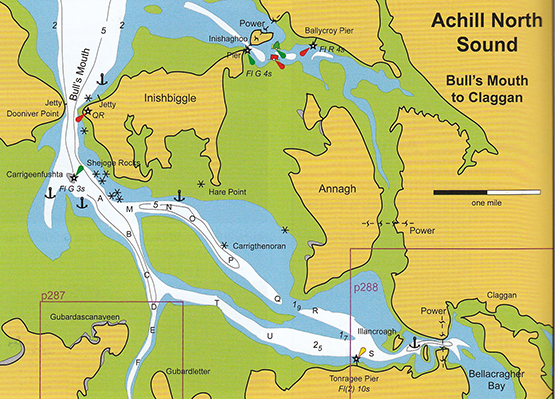
The northern area of Achill Sound is one of the areas re-surveyed for the new Sailing Directions, and some previously unlisted anchorages have been detailed. Courtesy ICC
The other area getting the special Keane-Hennigan update is the south coast, eastward of Cork. Regular Afloat.ie visitors recently will be aware of the remarkable photo of Blind Harbour on the Waterford coast which they obtained with their Warrior 40 Coire Uisge anchored in this extraordinary gap in the cliffs. But as this coastline is much transitted by the large fleets from the East Coast trying to reach the promised cruising land of the Southwest, the good news is that Dunmore East is dredged and looking forward to further developments which will be more friendly to recreational boat users, Kilmore Quay is better run than ever, a real trophy facility for Wexford County Council, and even the utterly utilitarian ferry port of Rosslare – sometimes a crucial facility for small craft trying to negotiate Ireland’s tricky southeast corner – has been showing a friendlier attitude to boats in need in recent summers.
And yes, I know that strictly speaking Rosslare is not on the south coast, let alone the west coast. But the fact that it gets included shows the generously informative approach which the Editor and his team have taken with this fine book, which retails at €33.75.
Buy the book HERE
Ireland’s Donegal Puts Itself On The Cruising Map
Rugged Donegal in the far northwest of Ireland is unknown territory for many Irish people whether by land or sea - and even more so for people from further afield writes W M Nixon. Yet for people who live in this picturesque but challenging region, it’s the hub of the universe, and for Donegal-located sailing enthusiasts, it can be a cruising paradise.
This was brought home to the rest of us at the recent Irish Cruising Club prize-giving, when the Glengarriff Trophy for the best cruise in Irish waters went to Dr Paul McSorley, who sails from Lough Swilly. Despite 2015’s mixed weather, he made a very detailed cruise of the Donegal coast with his daughter Eimile in the 27ft International H Boat Wild Cat. While the H Boats were developed in Finland as a fast weekend cruiser with genuine race potential (they’re now an International Racing Class), it’s unlikely that designer Hans Groop envisaged them cruising the monumental Donegal coast with its challenging location on the Wild Atlantic Way.
 An H Boat in cruising mode. Paul & Eimile McSorley’s cruise in Donegal in 2015 with with the H Boat Wild Cat was awarded an ICC Trophy
An H Boat in cruising mode. Paul & Eimile McSorley’s cruise in Donegal in 2015 with with the H Boat Wild Cat was awarded an ICC Trophy

A Land Apart – Donegal is Ireland’s ultimate cruising challenge
Yet on a good day, you could see resemblances between the myriad of islands on the Finnish coast and the maze of islands north and south of Arranamore between Dawros Head and Bloody Foreland, the area on which Wild Cat’s cruise was concentrated. The difference, of course, is the tide. But Donegal aficionados reckon that the tide adds a special spice in which the Baltic is woefully lacking……
Whatever, there’s no doubt that Donegal is a special place for many cruising folk, and in recent days the ever-curious Norman Kean and Geraldine Hennigan of Courtmacsherry, who edit the Irish Cruising Club Sailing Directions, have been in Donegal sussing out welcome new developments. In a sense, it was something of a home-coming, for when Norman first came from Scotland to settle in Ireland to work in a chemical plant in Derry, Lough Swilly Yacht Club became his home base, and it was a cruise from there to the Faroes in an own-built Sadler 25 which first put him on the cruising map.
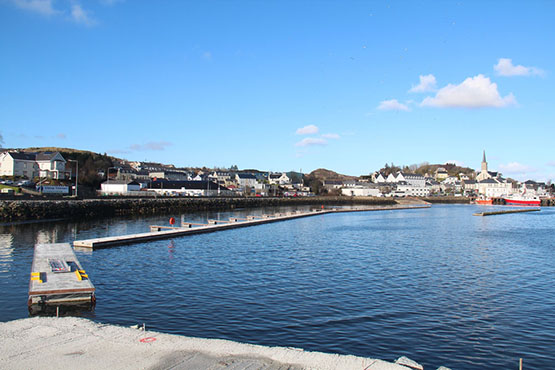
This is the start of something very worthwhile – the first pontoon berths in place in Killybegs in Donegal last week. Photo: Geraldine Hennigan
In Donegal in late February 2016, they found that the further you go south, the more promising are the developments. Best of all is the mighty fishing port of Killybegs on the south coast facing into Donegal Bay, a wonderful natural harbour for a bustling place which is said to be a town of 23 millionaires. For although not everyone does well in the fishing, some busy and innovative types do very well indeed.
For quite some time there’s been talk of the provision of pontoon facilities in Killybegs, but for 2016 Donegal County Council - where Cathal Sweeney has become the enthusiastic harbour engineer - have just gone ahead and done it with a minimum of fanfare, installing a 63-berth pontoon setup with plenty of room for expansion. (As first reported by Afloat.ie in March 2013). The pontoons were supplied and fitted by Oliver Shortall's Inland and Coastal Marinas Ltd of Banagher in County Offaly.
At present it’s called a “Small Craft Harbour”, which at first you might think reflects the reluctance of local authorities, the further north you go in Ireland, to describe a new amenity of this type as a “marina”. A case in point is Ardglass in County Down where the excellent little marina – one of the greatest boons to East Coast cruising – is still referred to as the “Phenick Cove Boat Park”.
On the other hand, Cathal Sweeney sounds a no-nonsense kind of guy, so maybe he won’t describe the very welcome new facility in Killybegs – which will transform Donegal as a cruising ground in providing a convenient base where a boat could be confidently left with good if distant communications with the rest of the country – as a marina until it has the full shoreside facilities.
Then the cruising options from Killybegs have been improved too, as to the westward a fine big pontoon has now been provided at the west pier in the lovely inlet of Teelin right beside the majestic cliffs of Slieve League. But then as we head north along the massive Atlantic seaboard, proper facilities are sparse enough, though in the case of both Burtonport and Bunbeg, it’s surely only a matter of time before a proper recreational-use pontoon or two gets installed.

Bunbeg on Donegal’s northwest corner is a little port which would benefit from a modest pontoon facility. Photo: W M Nixon
Cruising Donegal’s north coast, it still remains a source of wonder and delight that Tory Island now has a proper pier, albeit a tiny one, at which a cruising yacht can confidently overnight. And further east we hear that the most sheltered anchoring spot on the entire north coast, Fanny’s Bay on the west side just inside the entrance to Mulroy Bay, is a real possibility for a small marina facility.
Nevertheless in cruising Donegal, your first requirement is for your vessel to have her own fully operational and very substantial ground tackle, for apart from this being the seamanlike approach, the choice of anchorages which opens up when you know you’ve an anchor which will hold, and a windlass which will retrieve it, is almost boundless.

After many years, the shoreside cohesion of Fahan Marina on Lough Swilly with its landward neighbourhood south of Buncrana still seems a long way off. Photo Kevin Dwyer/Courtesy ICC
In the northeast of this enormous county of Donegal, there has of course long been a convenient if somewhat tide-ridden pontoon at Rathmullan on the west shore of Lough Swilly, but across-lough at Fahan, the marina – the great white hope of Donegal sailing – continues in a sort of semi-functional limbo, an unfinished, disconnected piece of work which nevertheless gives enough hint of what might be, if only someone could find a way through various legal and commercial impasses.
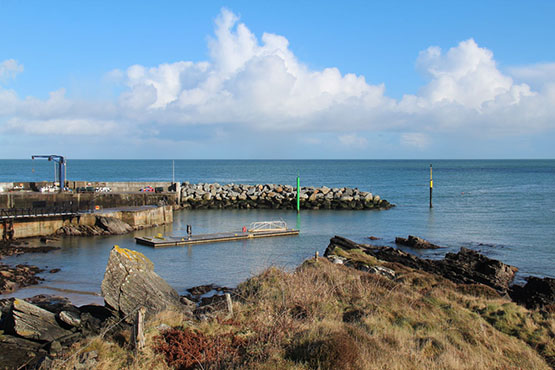
The berthing facility at Bunnagee near Culdaff took a battering in the winter storms. Photo: Geraldine Hennigan
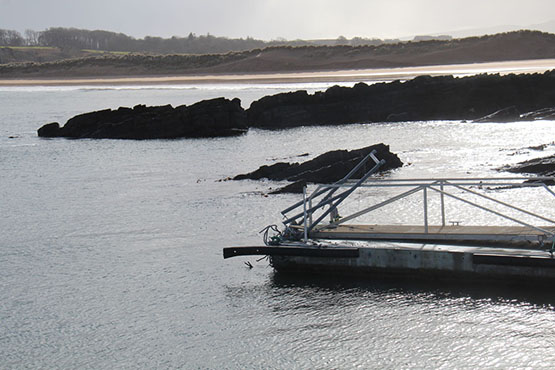
Storm damage to one of the Bunagee pontoons. Photo: Geraldine Hennigan
Up to the north of Inishowen, what was hoped to be a “marina” at the lovely little bay of Bunagee at Culdaff has seen its pontoon damaged in winter storms, for even in summer this is a restless if attractive anchorage. But on the east coast of Inishowen the Greencastle-Moville area has seen significant improvement with summer harbour for Moiville Yacht Club close south of Greencastle, where the main harbour itself has seen work resumed on some improvements.
Greencastle is a fishing port where occasionally working boats and leisure craft can become very crowded……Photo: W M Nixon
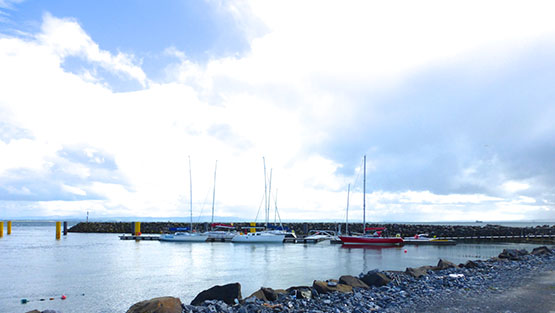
The new Greencastle pontoons looking east across Lough Foyle. In time, an additional sheltering pier may make this a more attractive proposition for visiting cruising boats. Photo: W M Nixon
So Donegal calls. It may get some of the roughest weather in Europe, but when summer comes to stay for a week or two, it’s a cruising paradise.
ISA Cruising Conference Was On Target For Topics And Turnout
Last Saturday’s Irish Sailing Association National Cruising Conference, sponsored by Union Chandlery with full organisational support from the Cruising Association of Ireland and the enthusiastic hospitality of Howth Yacht Club, was able to put through a very complete day-long programme which covered an extraordinary variety of topics. Each area of interest was examined in detail by a leading expert – in some cases the CEO of the national agency involved – and by the end the attendees, who came from all over the country, were verging on information overload. Yet everyone finished the day well satisfied, and certainly agreed on one thing – it will be quite something to match the quality of 2016’s Cruising Conference when the next one comes round in 2018. W M Nixon was there, and though he tells us “his head was melted” with the sheer volume of the range of issues discussed and explained, he’ll do his best to let us know what happened.
It went on for seven hours and more, and ranged from the extremities of dealing with calving glaciers in Greenland at one end, to the niceties of lone male watch-keepers dealing safely and efficiently with the calls of nature in mid ocean at the other. And since you ask, there were two distinct camps for dealing with Problem B – those who favour a simple bottle, narrow enough to be stowed in a convenient winch handle holder, and those who think a yoghurt tub with its cover kept usable is your only man, as some folk need a bit of space to perform.
As for the sheer length of the programme, as a group of friends and shipmates attending together we agreed it should have been an hour shorter. But then we couldn’t think of one single item on the agenda that we would have happily discarded. So for 2018 (or next year, if the current plan to make it biennial is reckoned to be wimpishly unambitious), Paddy McGlade the ISA Board Member for Cruising, and Clifford Brown, Commodore of the Cruising Association of Ireland, will have to agree to the same densely-filled programme, and it’s beholden on the participants and the audience to be up for the challenge.
For the fact is, when you get an attendance of this calibre, you need to provide the full coverage in the programe. And if you’re providing the full service in the form of a very comprehensive conference, then you deserve the attendance of all the keenest cruising folk – or would-be cruising folk – in the entire country. And with a comprehensive turnout of 104 enthusiasts where all nvolved on either side of the programe are incuded - when they’d tried initially to keep the numbers manageably at 80 - the dynamic interaction between performers and audience was magic, and ISA President David Lovegrove was properly impressed.
ISA Cruising Convener Gail MacAllister put together a cracking programme, nicely balancing the serious issues which might have had a certain bureaucratic overtone with more overtly entertaining stuff which hit the button either by scaring us stiff, or else making us savour the pure quiet delight of a proper cruise going well with a contented crew on board.
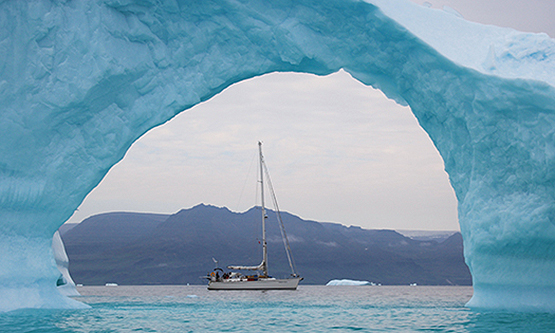
Eddie Nicholson’s Najad 440 Mollihawk’s Shadow in the frame in Greenland. The outline he gave of the pre-planning and execution with shipmates Mike Hodder and Dermot O’Morchoe of this exemplary cruise from Newfoundland eventually home to Ireland was to set the tone for the ISA Cruising Conference.
The tone was set from the start with the all-singing all-dancing account of Eddie Nicholson of Kinsale’s cruise to West Greenland and then on to Ireland from Labrador with the Najad 440 Mollihawk’s Shadow. This was much more than the narrative of an ambitious cruise. Combined with his two leading shipmates Mike Hodder and Dermot O’Morchoe, Eddie makes up a threesome of complementary talents, and their thoughtful account of what goes into planning, preparing and making such a cruise the outstanding success it clearly became was shown in the concluding informative account of what they achieved, once they’d made the effort to put everything in place.
This was obviously at the more advanced end of cruising, so as a balance we next heard from ISA Board Member Pierce Purcell of Galway, who has been on a personal crusade to fire up the interest of all recreational boat owners around Galway Bay. He runs a chandlery at Clarinbridge, and the sheer variety of people from all parts who were coming through his door in quest of maritime items large and small made him realise that his shop was a maritime focal point for the entire Galway Bay area.
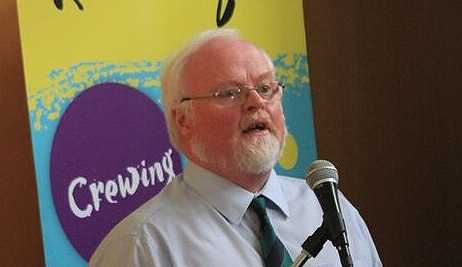
Pierce Purcell of the ISA Board outlining his innovative technique for building up a communications network of recreational boating enthusiasts around Galway Bay
So every time he sold something, he simply asked the customer if he could have their email address to keep them informed of anything that might be in the offing for boaters large and small around Galway Bay. As a result, in the last decent summer, which we had a couple of years ago if you remember, he managed to assemble a fleet of fifty-plus boats for a Bank Holiday weekend muster at Kilronan in the Aran Islands. And as a direct result of that, the WIORA Championship 2017 is going to be staged at the same venue, which will be a remarkable “first”.
The extraordinary opportunities which cruising offers for observing maritime wildlife were then outlined by Simon Berrow of the Irish Whale & Dolphin Group, and his continuing enthusiasm is at such a level that just about everyone present will be on some sort of whale watch in the season ahead.
Dr Berrow is based in Kilrush, and there’s something about the West of Ireland which sets the sailing heart afire, for we then had Daria Blackwell of Clew Bay telling us how women can get much greater enjoyment from sailing if they take steps to learn how to do it themselves, indeed the best thing is to do it well because you want to, not because some mere male needs help.

Daria Blackwell delivering the message about women adopting a more proactive role in sailing through having the most positive attitude to learning and practice. Photo: Alex Blackwell

Molly Childers on the wheel aboard Asgard in 1912. She was a much more competent helm than her husband Erskine, and it was she who made such a masterful job of steering the engine-less Asgard into Howth with a strong following wind during the gun-running episode in 1914.
This made it doubly appropriate that the conference was taking place in Howth Yacht Club, for of course in July 1914 Howth witnessed one of the finest examples of skilled helming by a woman when Molly Childers steered the engineless Asgard safely into harbour and alongside in the allotted tight berth for the Irish Volunteers Gun Running, despite a Force 5 to 6 northwest wind from dead astern.
Daria used to be the boss of a 400–employee advertising agency in New York, so when she got the sailing bug she went at it with total dedication. It made for a fascinating presentation as she outlined the different ways that men and women approach something like learning to helm a boat in confined situations.
Apparently we men rely on intuitive learning – we hope to pick it up simply by doing it. And if it involves fixing a piece of equipment, we’d rather have a blind go at it instead of RTFM. But women, according to Daria, want to learn properly - they want to practice, they’re keen to take instruction if it’s properly done, and they want to continue to get it right without feeling nervous about doing it again. Practice and self-reliance – that’s what women bring to enjoyment of sailing. And yes, they do read the manual.
Norman Kean of Courtmacsherry, Honorary Editor of the Irish Cruising Club Sailing Directions, is a typical Royal Institute of Navigation person in that, while he’s ace with all the latest equipment, he has a great love and respect for all the paraphernalia of his art, and he adores charts. But he doesn’t suffer from any illusions about the fact that some of our best-loved charts are based on data so old that a re-survey would show that some narrow channels are not quite where they’d be indicated on an electronic chart, where the original info has had to come from a paper chart.
So in an intriguing presentation he showed us some electronic anomalies of which the most vivid was the slight but crucial mis-placing of the Joyce Sound inside Slyne Head in County Galway, and then he went on to show us how much attention to detail was needed for himself and Geraldine to take their Warrior 40 Coire Uisge into Blind Harbour on Waterford’s Copper Coast.

Coffee break. Navigation guru Norman Kean (facing left) talks charts with fellow enthusiasts. Photo: W M Nixon
The organisers maintained a ferocious pace, for before we were allowed to take time for lunch, there was a break-out session with instant groups of eight or so each being formed to discuss various topics on which, at conferences end, one lucky nominee from each group had to produce a considered report. My recollection is that the problem with lobster pot marker lines loomed large, and in our group we’d the good fortune to have Paddy Judge who told us how he’d cleared a pot line which had got between his skeg and rudder – thereby disabling his steering. He’d managed to get to the lobster line by use of a short length of chain with a line at either end, the chain let over the bow with the line to each side, and then worked aft well under water until it could be used to raise the pot line, which was running vertically downwards from the rudder.
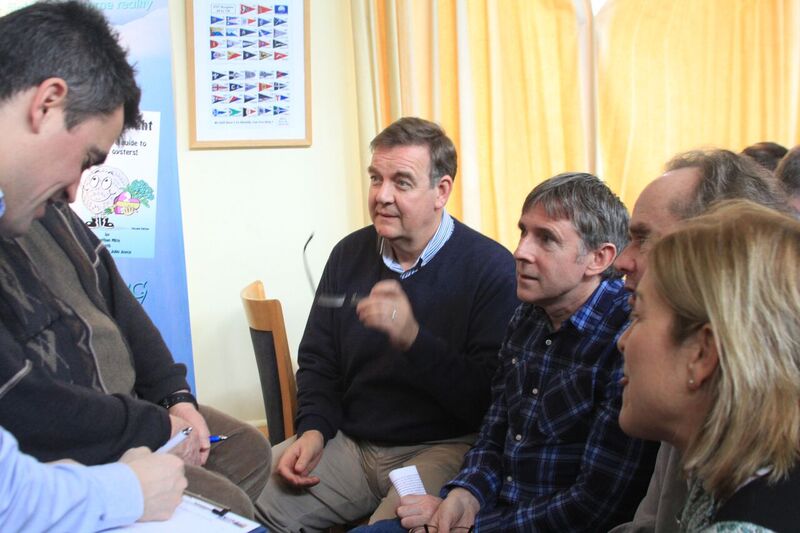
Taking a day off from the general election, RTE News Presenter Brian Dobson was one of 104 cruising and offshore sailors who took part in the ISA Conference. Photo: Alex Blackwell
The whole business of virtually unmarked pot lines all round the Irish coast is becoming such a problem that we’ll probably have a blog completely devoted to it one day. But the good news from Saturday is that the energetic Gary Davis of the HYC Cruising Group has been so determined in his lobbying of politicians and government departments regarding the menace of poorly-marked pot lines that it’s now on the official agenda, which is quite a step forward from the previous apparent indifference.
The conclusions from the break-out groups were to come at the end of the Conference, and provided food for thought with Gary Davis’s news about the new political awareness getting much approval, while there was something of a round of applause for Paddy Judge’s ingenious solution – I omitted to mention he was single-handed at the time of the incident.
The afternoon went promptly into further presentations, with CAI Commodore Clifford Brown putting out the welcome mat for newcomers in a big way. If you wanted to find a catchphrase for the entire conference, “infectious enthusiasm” would be right on target, and Commodore Brown’s exposition, cheerfully outlining the multiple choice in sailing and cruising experience which the CAI members are happy to offer to anyone even slightly interested, was encouraging to behold.

“You’re all welcome, very welcome….” Cruising Association of Ireland Commodore Clifford Brown outlines what his organisation has to offer to experienced sailors and absolute beginners alike. Photo: Alex Blackwell
A star performer. Pat Murphy’s guidance on welcoming and managing new crew drew on his unrivalled experience gained in a nine year round the world cruise. Photo: W M Nixon
However, “inspiring” is the only way to describe the next speaker. Pat Murphy has his top place for ever inscribed in Irish sailing history thanks to his fabulous nine year voyage round the world with his late wife and soulmate Olivia on their fine 40ft cutter Aldebaran. They learned much from it, and as they had guest crews aboard at regular intervals, they learned a great deal more about how to manage and welcome new crew. Pat was hugely generous in imparting nuggets of sound advice and insights culled from an exceptional cruise, and it all combined into a solid body of purest wisdom.
But then came the really serious bit. Chris Reynolds, Director of the Irish Coastguard, took us on an informative tour of his expanding organization, and guided us on the paths to sea safety and the correct course of action in an emergency. These topics had of course come up during the group discussions, where the more senior cruising folk inclined to the view that the joy of cruising is to be found in self-reliance, and if a problem arises you should take pride and satisfaction in solving it yourself, however much the potential or actual risk.

The friendly face of the rescue services – Chris Reynolds is Director of the Irish Coastguard. Photo: Alex Blackwell
But that was appropriate a long time ago, before a proper matrix of rescue and support serves was in place. You just had to be almost totally self-reliant in the old days. Yet nowadays, according to Chris Reynolds, it’s irresponsible to persist in that attitude. His message was simple. If you think you might be getting into trouble, then it’s time to alert the rescue service. For if you know you’re getting into trouble, then it may already be too late to call the rescue services.
This caused some heart-searching among traditionalists, but we hadn’t time to dwell on it, as the next speaker was the force of nature otherwise known as Vera Quinlan of INFOMAR in the Marine Institute in Galway. INFOMAR is the INtegrated Mapping FOr the sustainable development of Ireland’s MARine resource, and Vera Quinlan – a noted ocean cruising sailor in her own right – has been at the heart of it for eight years.
A Force of Nature – Vera Quinlan of INFOMAR. Photo: W M Nixon
If anyone’s interest in the future of the sea had been flagging at this stage, Vera’s enthusiasm soon fired it up again. It’s a whole new world out there, on and under the ocean, when you see it through INFOMAR eyes. And Vera’s vision for Ireland’s maritime future was just the tonic for people who sometimes tend too much to see it as no more than a playground.
The fact that she both works with it, and shows its manifold possibilities for all sorts of sustainable uses, and then goes on to sail across it for pleasure every summer - that was thought-provoking in the extreme. And so too was the concluding item, which had John Leahy, former Commodore of the CAI and a retired airline captain, and Willemien Phelan of Met Eireann in an informal competition to see who had best predicted the weather which would obtain on the day of the conference, using different forecast models in different time spans.
Both had got it pretty much spot on in their predictions a week in advance, but then we were in a spell of routine winter weather with the Great Purple Snake of Atlantis, otherwise known as the Jetstream in high speed mode, weaving across the country with one unpleasantness fairly regularly after another.
“The Great Purple Snake of Atlantis” – Willemien Phelan of Met Eireann with a particularly lurid recent swirling of the Jetstream right across Ireland. Photo: W M Nixon
Since last weekend, as you’ll have noticed the Jetstream took off for two or three days to the sunny south, which consequently wasn’t sunny any more, but Ireland certainly was. However, the Great Snake of Atlantis is due back over us today, but at least you’ll know now why the weather goes to pot when it does.
All this was only part of the wide-ranging presentation given by John and Willemien which showed just how far weather prediction has come on in recent years. The magic Ten Day Forecast may still be out of reach beyond a certain level of accuracy, but they’re closing in on the one week forecast very well indeed these days.
All of which poses a quandary for anyone organising sailing events or planning cruises. For if all the forecasts give the same message, that in a week’s time the weather is going to be plain awful with too much wind for most racing, then you’re faced with the decision of calling it off with plenty of time to spare to enable people to plan other things, or else you just stick to the programme and hope the forecast has been excessively pessimistic.
And on top of that, if several days in advance you do cancel an event whose date was set way back in the winter, when on earth are you going to slot it in later in our current programme, which is jam-packed from one weekend to the next?
But that was only one of many thoughts flying around the Conference last Saturday, and most of them were much more cheerful. The reality is cruising folk just like to get together and talk about boats and cruising until the cows come home, and if a Cruising Conference is organized with a stellar line-up of speakers, it gives it all a sense of extra purpose.
Paddy McGlade, ISA Board Member for Cruising, reviews a successful conference. Photo: W M Nixon
Long after a deservedly happy Paddy McGlade brought this part of the gathering to a conclusion after the draw for the offshore sailing suit donated by Union Chandlery had resulted in a popular win for Terry McCoy of Skerries, people were still contentedly shooting the breeze in the friendly atmosphere of the clubhouse. And the really keen ones were lining themselves up for that night’s annual dinner of the CAI. Cruising people are like that – they’re in for the long haul.

It’s all for Terry! Terry McCoy with Gail MacAllister after the Skerries sailor had won the draw for the sailing suit. Photo: Alex Blackwell
Inaugural Cruising Conference At Howth
The inaugural ISA Cruising Conference at Howth Yacht Club attracted 90 sailors for a very informative day last Saturday.
ISA President David Lovegrove opened proceedings and Keynote speaker Eddie Nicholson and his crew entertained with an excellent show on their adventures to Greenland, with stunning photography, video footage and some eye opening tales of ice movement and local culinary delights. Simon Berrow, of Irish Whale and Dolphin Group and Galway / Mayo Institute of Technology, shared his knowledge of the biodiversity of whales and mammals along our Irish Coastline and gave advise on how leisure boat should approach them and help to ensure their safety.
Sponsorship from Union Chandlery and support from Cruising Association of Ireland helped to made the day a great success, along with the contributions and support from Nicky’s Place on Howth Pier, ICC Publications, Wild Atlantic Way, Met Eireann, INFOMAR, DTTAS, RNLI, Helly Hansen, IWDG, Cool Route & Howth Yacht Club all combined to give every delegate a bag full of fun goodies and useful information.
Experienced offshore sailor and author, Daria Blackwell, made a number of male skippers stop and think, with a talk on Women at the Helm. Many women take on the role of crew on board and never actually helm or rather I should say, skipper. The question that had many male skippers thinking was “If you fell overboard, would your crew be able action a safe ‘man over board?”. Not to mention how much easier it is helm a yacht in to a marina than to be the one jumping off with a line in one hand and a fender in the other. Norman Kean, Fellow of the Royal Institute of Navigation and ICC Publications Editor, gave an excellent explanation of the difference between Vector and Raster Electronic Charts, that left the audience assured that maintaining their knowledge of paper pencil navigation alongside their electronic navigation is always a good idea.
Clifford Brown of the Cruising Association of Ireland brought the room up to date with CAI’s “Crew Together” programme, where the East, West and South coast sailors match crew with boats and give sailors a chance to cruise in each others’ waters. Round the world sailor, Pat Murphy, entertained everyone with his tips on caring for, training and communicating with crew for cruising. In the ethos of the ISA programme of Try Sailing, cruising sailors were encouraged to welcome new crew on board and give them a chance to ‘Try Crewing’.
Vera Quinlan of the INFOMAR project at the Marine Institute, and experienced skipper, had everyone amazed by the detailed information available on the sea bed and the idea of being able to know just where your anchor is landing and what you are sailing over. She had everyone eager to learn more. The final talk on weather could have lasted all day as we all know how important forecasting is for sailing, especially in Irish waters. Willemien Phelan of Met Eireann and Volvo Ocean Race participant, gave a fantastic explanation of weather forecasting with John Leahy, Yachtmaster instructor and pilot.
Irish Cruising Comes Centre Stage In Howth Yacht Club
With last night’s Irish Cruising Club Annual General Meeting & Prize-Giving hosted at Howth Yacht Club, and this morning’s day-long ISA Cruising Conference at the same venue, centre stage has been taken by the silent majority – the large but distinctly reticent segment of the sailing population which emphatically does not have racing as its primary interest afloat. W M Nixon takes us on a guided tour.
The great Leif Eriksson would approve of some of the more adventurous members of the Irish Cruising Club. They seem to be obsessed with sailing to Greenland and cruising along its coast. And it was the doughty Viking’s father Erik Thorvaldsson (aka Erik the Red) who first told his fellow Icelanders that he’d given the name of Greenland to the enormous island he’d discovered far to the west of Iceland. He did so because he claimed much of it was so lush and fertile, with huge potential for rural and coastal development, that no other name would do.
Leif then followed in the family tradition of going completely over the top in naming newly-discovered real estate. He went even further west and discovered a foggy cold part of the American mainland which he promptly named Vinland, as he claimed the area was just one potential classic wine chateau after another, and hadn’t he brought back the vines to prove it?
In time, Erik’s enthusiasm for Greenland was seen as an early property scam. For no sooner had the Icelanders established a little settlement there around 1000 AD than a period of Arctic cooling began to set in, and by the mid-1300s there’d been a serious deterioration of the climate. What had been a Scandinavian population of maybe five thousands at its peak faded away, and gradually the Inuit people – originally from the American mainland – moved south from their first beachheads established to the northwest around 1200 AD. They proved more successful at adapting to what had become a Little Ice Age, while no Vikings were left.
Now we’re in the era of global warming, and there’s no doubt that Greenland is more accessible. But for those of us who think that cruising should be a matter of making yourself as comfortable as possible while your boats sails briskly across the sea in a temperate climate or perhaps even warmer for preference, the notion of devoting a summer to sailing to Greenland and taking on the challenge of its rugged iron coast, with ice everywhere, still takes a bit of getting used to.
Yet in recent years the Irish boats seem to have been tripping over each other up there. And for some true aficionados, the lure of the icy regions was in place long before the effects of global warming were visibly making it more accessible.
Peter Killen of Malahide, Commodore of the Irish Cruising Club, is a flag officer who leads by example. It was all of twenty years ago that he was first in Greenland with his Sigma 36 Black Pepper, and truly there was a lot of ice about. The weather was also dreadful, while Ireland was enjoying the best summer in years.

Peter Killen’s Sigma 36 Black Pepper in local ice at the quay inside Cape Farewell in Greenland, August 1995

ICC Commodore Peter Killen’s current boat is Pure Magic, an Amel Super Maramu seen here providing the backdrop for a fine penguin in Antarctica, December 2004.
More recently, he and his crew of longterm shipmates have been covering thousands of sea miles in the Amel Super Maramu 54 Pure Magic, among other ventures having a look at lots more ice down Antarctic way to see how it compares with the Arctic. With all their wanderings, by the end of the 2014 season Pure Magic was laid up for the winter in eastern Canada in Nova Scotia. So of course in order to get back to Ireland through 2015, the only way was with a long diversion up the west coast of Greenland. And the weather was grand, while Ireland definitely wasn’t enjoying the best summer in years.
The Pure Magic team certainly believe in enjoying their cruising, however rugged the terrain. If the Greenland Tourist Board are looking for a marketing manager, they could do no better than sign up the skipper of Pure Magic for the job. His entertaining log about cruising the region – featured in the usual impressive ICC Annual edited for the fourth time by Ed Wheeler – makes West Greenland seem a fun place with heaps of hospitality and friendly folk from one end to the other.

If ice is your thing, then this is the place to be – Peter Killen’s Pure Magic off the west Greenland coast, summer 2015.
But then Peter Killen is not as other men. I don’t mean he is some sort of alien being from the planet Zog. Or at least he isn’t so far as I know. But the fact is, he just doesn’t seem to feel the cold. I sailed with him on a raw Autumn day some years ago, and while the rest of us were piling on the layers, our skipper was as happy as Larry in a short-sleeved shirt.
I’d been thinking my memory had exaggerated this immunity to cold. But there sure enough in the latest ICC Annual is a photo of the crew of Pure Magic enjoying a visit to the little Katersugaasivik Museum in Nuuk, and the bould skipper is in what could well be the same skimpy outfit he was wearing when we sailed together all those years ago. As for the rest of the group, only tough nut Hugh Barry isn’t wearing a jacket of some sort – even Aqqala the Museum curator is wearing one.
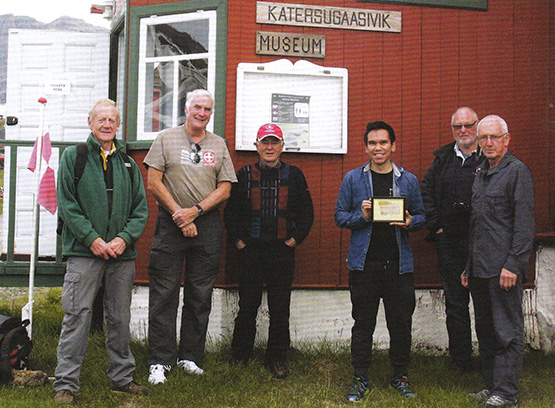
Some folk feel the cold more than others – Pure Magic’s crew absorbing local culture in Greenland are (left to right) Mike Alexander, Peter Killen, Hugh Barry, Aqqalu the museum curator, Robert Barker, and Joe Phelan
Having a skipper with this immunity to cold proved to be a Godsend before they left Greenland waters, when Pure Magic picked up a fishing net in her prop while motoring in a calm. Peter Killen has carried a wetsuit for emergencies for years, and finally it was used. He hauled it on, plunged in with breathing gear in action, and had the foul-up cleared in twenty minutes. Other skipper and Commodores please note……
The adjudicator for the 2015 logs was Hilary Keatinge, who has one of those choice-of-gender names which might confuse, so it’s good news to reveal that after 85 years, the ICC has had its first woman adjudicator. No better one for the job, man or woman. Before marrying the late Bill Keatinge, she was Hilary Roche, daughter of Terry Roche of Dun Laoghaire who cruised the entire coastline of Europe in a twenty year odyssey of successive summers, and his daughter has proven herself a formidable cruising person, a noted narrator of cruising experiences, and a successful writer of cruising guides and histories.
Nevertheless even she admitted last night that once all the material has arrived on the adjudicator’s screen, she finally appreciated the enormity of the task at hand, for the Irish Cruising Club just seems to go from strength to strength. Yet although it’s a club which limits itself to 550 members as anything beyond that would result in administrative overload and the lowering of standards, it ensures that the experience of its members benefit the entire sailing community through its regularly up-dated sailing directions for the entire coast of Ireland. And there’s overlap with the wider membership of the Cruising Association of Ireland, which will add extra talent to the expert lineup providing a host of information and guidance at today’s ISA Cruising Conference.
But that’s this morning’s work. Meanwhile last night’s dispensation of the silverware – some of which dates back to 1931 – revealed an extraordinarily active membership. And while they did have those hardy souls who ventured into icy regions, there were many others who went to places where the only ice within thousands of miles was in the nearest fridge, and instead of bare rocky mountains they cruised lush green coasts.
Nevertheless the ice men have it in terms of some of the top awards, as Hilary Keatinge has given the Atlantic Trophy for the best cruise with a passage of more than a thousand miles to the 4194 mile cruise of Peter Killen’s Pure Magic from Halifax to Nova Scotia to Howth, with those many diversions on the way, while the Strangford Cup for an alternative best cruise goes to Paddy Barry, who set forth from Poolbeg in the heart of Dublin Port, and by the time he’d returned he’d completed his “North Atlantic Crescent”, first to the Faeroes, then Iceland to port, then across the Denmark Strait to southeast Greenland for detailed cruising and mountaineering, then eventually towards Ireland but leaving Iceland to port, so they circumnavigated it in the midst of greater enterprises.
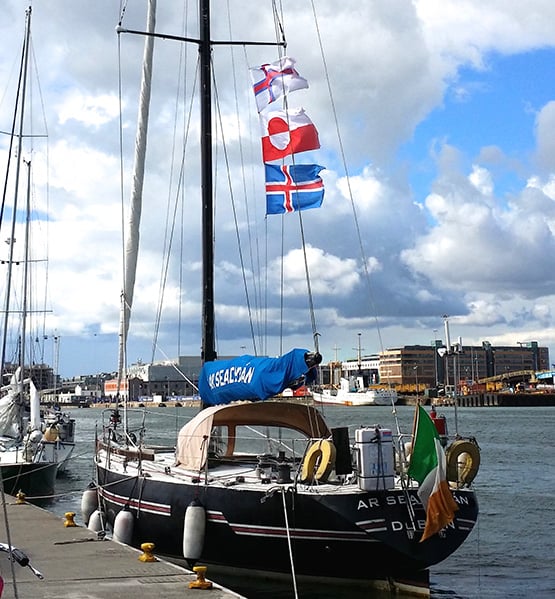
You collect very few courtesy ensigns in the frozen north. Back at Poolbeg in Dublin after her “North Atlantic Crescent” round Iceland and on to Greenland, Paddy Barry’s Ar Seachran sports the flags of the Faroes, Iceland and Greenland. Ar Seachran is a 1979 alloy-built Frers 45. Photo: Tony Brown
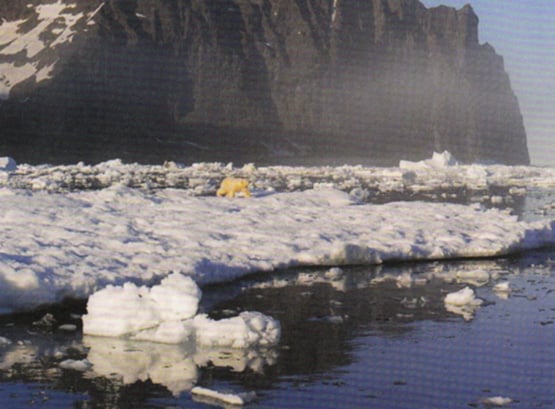
“Definitely the Arctic”. A polar bear spotted from Ar Seachran. Photo: Ronan O Caoimh
Paddy Barry started his epic ocean voyaging many years ago with the Galway Hooker St Patrick, but his cruising boat these days is very different, a classic Frers 45 offshore racer of 1979 vintage. Probably the last thing the Frers team were thinking when they turned out a whole range of these gorgeous performance boats thirty-five years ago was that their aluminium hulls would prove ideal for getting quickly to icy regions, and then coping with sea ice of all shapes and ices once they got there. But not only does Paddy Barry’s Ar Seacrhran do it with aplomb, so too does Jamie Young’s slightly larger sister, the Frers 49 Killary Flyer (ex Hesperia ex Noryema XI) from Connacht, whose later adventures in West Greenland featured recently in a TG4 documentary.
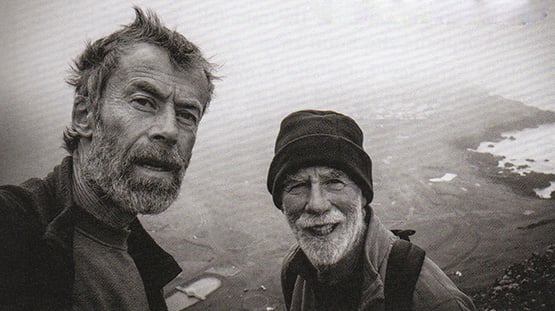
“A grand soft day in Iceland”. Harry Connolly and Paddy Barry setting out to take on mountains in Iceland during their award-winning cruise to Greenland. Photo: Harry Connolly
Pure Magic and Ar Seachran are hefty big boats, but the other ICC voyager rewarded last night by Hilary Keatinge for getting to Arctic waters did his cruise in the Lady Kate, a boat so ordinary you’d scarcely notice her were it not for the fact that she’s kept in exceptionally good trim.
Drive along in summer past the inner harbour at Dungarvan in West Waterford at low water, and you’ll inevitably be distracted by the number of locally-based bilge-keelers sitting serenely upright (more or less) on that famous Dungarvan mud. There amongst them might be the Moody 31 Lady Kate, for Dungarvan is her home port.
But she was away for quite a while last year, as Donal Walsh took her on an extraordinary cruise to the Arctic, going west of the British mainland then on via Orkney and Shetland to Norway whose coast goes on for ever until you reach the Artic Circle where the doughty Donal had a swim, as one does, and looked at a glacier or too, and then sailed home but this this time leaving the British mainland to starboard. A fabulous 3,500 mile eleven week cruise, he very deservedly was awarded the Fingal Cup for a venture the adjudicator reckons to be extra special – as she puts it, “you feel you’re part of the crew, though I don’t think I’d have done the Arctic Circle swim.”
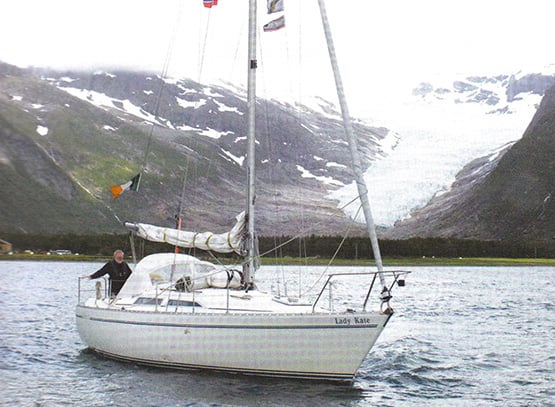
A long way from Dungarvan. Lady Kate with Donal Walsh off the Svartsen Glacier in northern Norway
Indeed, in taking an overview of the placings of the awards, you can reasonable conclude that the adjudicator reckons any civilized person can have enough of ice cruising, as she gives the ICC’s premier trophy, the Faulkner Cup, to a classic Atlantic triangle cruise to the Azores made from Dun Laoghaire by Alan Rountree with his van de Sadt-designed Legend 34 Tallulah, a boat of 1987 vintage which he completed himself (to a very high standard) from a hull made in Dublin by BJ Marine.
Tallulah looks as immaculate as ever, as we all saw at the Cruising Association of Ireland rally in Dublin’s River Liffey in September. And this is something of a special year for Alan Rountree, as completely independently of the Faulkner Cup award, the East Coast ICC members awarded their own area trophy, the Donegan Cup for longterm achievement, to Tallulah’s skipper. As one of those involved in the decision put it, basically he got the Donegan Trophy “for being Alan Rountree – what more can be said?”
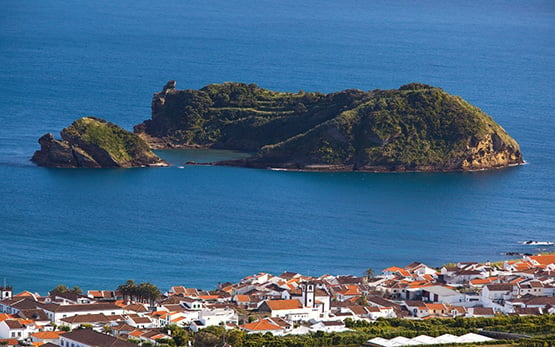
The essence of the Azores. Red roofs maybe, but not an iceberg in sight, and the green is even greener than Ireland. Alan Rountree’s succesful return cruise to the Azores has been awarded the ICC’s premier trophy, the Faulkner Cup.

Tallulah at the CAI Rally in the Liffey last Setpember. She looks as good today as when Alan Rountree completed her from a bare hull nearly thirty years ago. Photo: W M Nixon
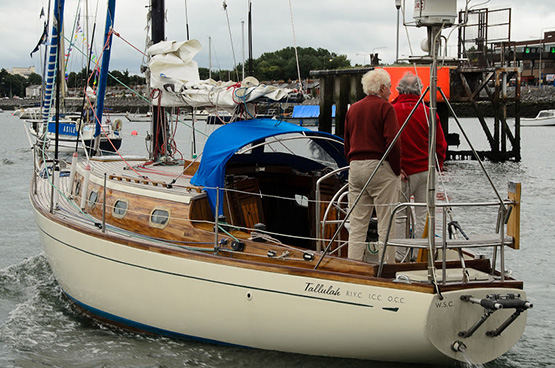
A boat to get you there – and back again. Tallulah takes her departure from the CAI Rally in Dublin. Photo: Aidan Coughlan
Well, it can be said that his Azores cruise was quietly courageous, for although the weather was fine in the islands, the nearer he got to Ireland the more unsettled it became, and he sailed with the recollection of Tallulah being rolled through 360 degrees as she crossed the Continental Shelf in a storm in 1991. But he simply plodded on through calm and storm, the job was done, and Tallulah is the latest recipient of a trophy which embodies the history of modern Irish cruising.
There were many other awards distributed last night, and for those who think that the ICC is all about enormous expensively-equipped boats, let it be recorded that the Marie Trophy for a best cruise in a boat under 30ft long went to Conor O’Byrne of Galway who sailed to the Hebrides with his Sadler 26 Calico Jack, while the Fortnight Cup was taken by a 32-footer, Harry Whelehan’s Jeanneau Sun Odyssey 32 for a fascinating cruise in detail round the Irish Sea, an area in which, the further east you get to coastlines known to very few Irish cruising men, then the bigger the tides become with very demanding challenges in the pilotage stales.
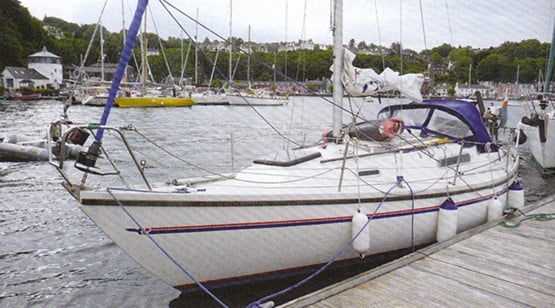
The smallest boat to be awarded a trophy at last night's Irish Cruising Club prize-giving was Conor O’Byrne’s Sadler 26 Calico Jack, seen here in Tobermory during her cruise from Connacht to the Hebrides
As for “expensively equipped”, the Rockabill Trophy for seamanship went to Paul Cooper, former Commodore of Clontarf Yacht & Boat Club and an ICC member for 32 years, who solved a series of very threatening problems with guts and ingenuity aboard someone else’s Spray replica during a 1500 mile voyage in the Caribbean, with very major problems being skillfully solved, as the judge observed, “without a cross word being spoken”.
Not surprisingly in view of the weather Ireland experienced for much of the season, there were no contenders for the Round Ireland cruise trophy, though I suppose you could argue that the return of Pure Magic meant the completion of a round Ireland venture, even if in this case the Emerald Isle becomes no more than a mark of the course.
In fact, with the unsettled weather conditions of recent summers in Ireland , there’s now quite a substantial group of ICC boats based out in Galicia in northwest Spain, where the mood of the coast and the weather “is like Ireland only better”. The ICC Annual gives us a glimpse of the activities of these exiles, and one of the most interesting photos in it is provided by Peter Haden of Ballyvaughan in County Clare, whose 36ft Westerly Seahawk Papageno has been based among the Galician rias for many years now.
Down there, the Irish cruising colony can even do a spot of racing provided it’s against interesting local tradtional boats, and Peter’s photo is of Dermod Lovett of Cork going flat out in his classic Salar 40 Lonehort against one of the local Dorna Xeiteras, which we’re told is the Galician equivalent of a Galway Bay gleoiteog. Whatever, neither boat in the photo is giving an inch.
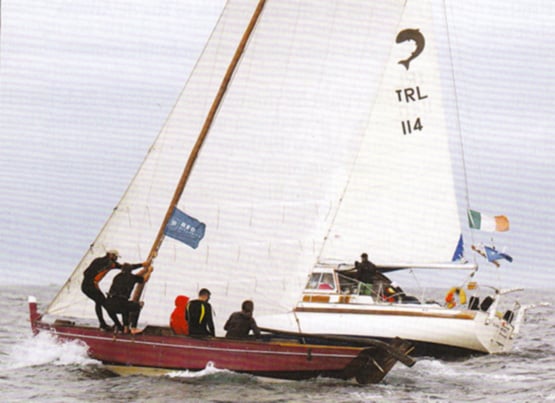
So who never races? Dermod Lovett ICC in competition with his Salar 40 Lonehort against a local traditional Dorna Xeiteira among the rias of northwest Spain. Photo: Peter Haden
Hilary Keatinge’s adjudication is a delight to read in itself, and last night after just about every sailing centre in Ireland was honoured with an ICC award for one of its locally-based members, naturally the crews leapt to the mainbrace and great was the splicing thereof.
But it’s back to porridge this morning in HYC and the serious work of the ISA Cruising Conference, where the range of topics is clearly of great interest, for the Conference was booked out within a very short time of being highlighted on the Afloat.ie website.
It’s during it that we’ll hear more about that intriguing little anchorage which provides our header photo, for although it could well be somewhere on the Algarve in Portugal, or even in the Ionian islands in Greece were it not for the evidence of tide, it is in fact on the Copper Coast of south Waterford, between Dungarvan and Dunmore East, and it’s known as Blind Harbour.
It’s a charming place if you’ve very settled weather, but it’s so small that you’d probably need to moor bow and stern if you were thinking to overnight, but that’s not really recommended anyway. Norman Kean, Editor of the Irish Cruising Club Sailing Directions, had heard about this intriguing little spot from Donal Walsh of Dungarvan (he who has just been awarded the Fingal Cup), and being Norman Kean, he and Geraldine just had to go and experience it for themselves. But it has taken three attempts to have the right conditions as they were sailing by, and it happened in 2015 in a very brief period of settled weather as they headed past in their recently-acquired Warrior 40 Coire Uisge, which has become the new flagship of the ICC’s informal survey flotilla.

The secret cove is to be found on Waterford’s Copper Coast, midway between Dungarvan and Dunmore East. Courtesy ICC
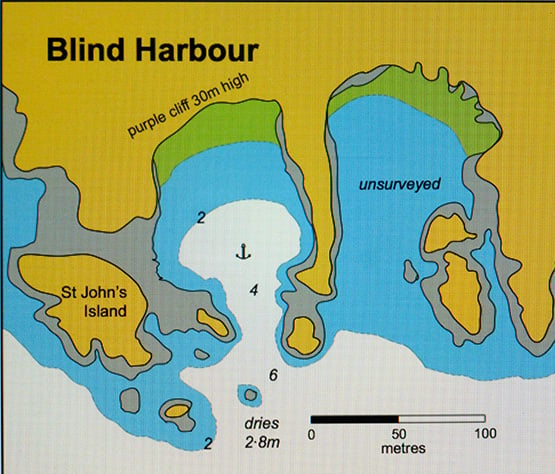
The newly-surveyed Blind Harbour on the Waterford coast as it appears in the latest edition of the ICC’s South & West Coasts Sailing Directions published this month. Courtesy ICC.
They found they’d to eye-ball their way in to this particular Blind Harbour (there are others so-named around the Irish coast) using the echo sounder, as any reliance on electronic chart assistance would have had them on the nearest part of County Waterford, albeit by only a matter of feet. With a similar exercise a couple of years ago, they found that the same thing was the case at the Joyce Sound Pass inside Slyne head in Connemara – rely in the chart plotter, and you’re making the pilotage into “impactive navigation”.
The message is that some parts of charts are still relying on surveys from a very long time ago, and locations of hyper-narrow channels may be a few metres away from where they actually are. On the other hand, electronic anomalies may arise. Whatever the reason, I know that a couple of years ago, in testing the ship’s gallant little chart plotter we headed for the tricky-enough Gillet passage inside the South Briggs at the south side of the entrance to Belfast Lough, and found that it indicated the rocks as shown were a tiny bit further north than we were seeing, which could have caused a but of a bump if we’d continued on our electronic way.
Electronic charts are only one of many topics which will be covered today. We hope to bring a full report next Saturday, for the participants will in turn require a day or two to digest their findings.



























